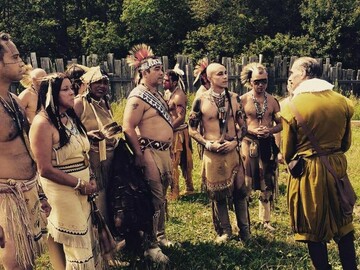Another feast in Patuxet (Plymouth): Excerpt from a letter from Emmanual Altham to Sir Edward Altham, September 1623
- Date
- September 1623
- Material
- Paper
- Author/Maker
- Emmanual Altham
- Source
Emmanual Altham to Sir Edward Altham, September 1623 in Three Visitors to Early Plymouth, ed. Sydney V. James Jr. (Plimoth Plantation, Inc. 1963)

Description
Despite promising beginnings, by 1622 diplomatic relations between many Wampanoag sachemships and Plymouth Colony had grown increasingly strained. After William Bradford refused to turn Tisquantum over to Ousamequin for an attempt to seize power, causing serious offense to the Pokanoket sachem which would certainly have resulted in Tisquantum’s death, communication broke down between the two communities for over a year. By summer 1623, contact had been restored and Ousamequin’s attendance at the wedding of William Bradford and Alice Southworth - along with four other Wampanoag sachems, his wife and a boy historians believed to be his son, Wamsutta, and a group of over 120 men and women - reestablished essential political and economic ties between some of the Wampanoag communities and Plymouth. Although the English writers do not list the sachems who attended with Ousamequin, Wampanoag historians suggest they were likely his brother Quadaqinna, the sachem of Nemasket, and Conacom sachem of Manomet.1
This diplomatic event was recorded by Emmanual Altham, an English gentleman and early investor in the Company of Adventurers of New Plymouth. Altham was one of dozens of English merchants who advocated for Plymouth Colony and provided essential financial support. Altham arrived in Plymouth Colony as “captain” (mercantile officer) of the Little James in the summer of 1623. In a letter to his brother, Altham describes the wedding. His writing offers a colonial outsider’s perspectives on Wampanoag and other Indigenous people and provides helpful details about celebrations that could help readers make educated guesses about what happened at the 1621 harvest celebration.
Transcription
And now to speak of the king of the country, who is a great emperor among his people. Upon the occasion of the Governor’s marriage, since I came, Massasoit [Ousemequin] was sent for to the wedding, where came with him his wife, the queen, although he hath five wives. With him came four other kings and about six score of men with their bows and arrows - where, when they came to our town, we saluted them with the shooting off of many muskets and training our men. And so all the bows and arrows was brought into the Governor’s house, and he brought the Governor three or four bucks and a turkey. And so we had very good pastime in seeing them dance, which is in such manner, with such noise that you would wonder. And at that time when we gave Massasoit [Ousemequin] his hat, coat, band and feather, I craved a boy of him for you, but he would not part with him; but I will bring you one hereafter. And now to say somewhat of the great cheer we had at the Governor’s marriage. We had about twelve pasty venisons, besides others, pieces of roasted venison and other such good cheer in such quantity that I could wish you some of our share…”2
Discussion Questions
-
Describe the Governor’s wedding in your own words or draw the scene based on Altham’s description. Who was there? What happened?
-
Have you ever been to a wedding? How was that wedding compared to this one?
-
What do the Governor’s wedding and the 1621 harvest celebration have in common?
- What details can help you draw conclusions about what might have also happened at the 1621 harvest celebration?
-
If you were a guest at the Governor’s wedding, how would you describe the event to a friend or family member? What do you think are the most important details to include?
-
How does Altham’s description of Ousamequin and his people reflect Altham’s English worldview?
- What does it mean when Altham says “I craved a boy of him”? How do you think that encounter made Ousamequin feel?
-
Based on what you have learned about Wampanoag people, what aspects of their culture did Altham misunderstand or stereotype?
Footnotes
- 1 Darius Coombs, “Wedding As Diplomacy,” interview by Hilary Goodnow. Interwoven, Plimoth Patuxet Museums, August 12, 2015.
- 2 Emmanuel Altham to Sir Edward Altham, September 1623 in Three Visitors to Early Plymouth, ed. Sydney V. James Jr. (Plimoth Plantation, Inc. 1963), 29-30. According to the editor’s notes, the original letter belonged to Dr. Otto Fisher of Detroit “who before his death generously consented to their first publication here.”